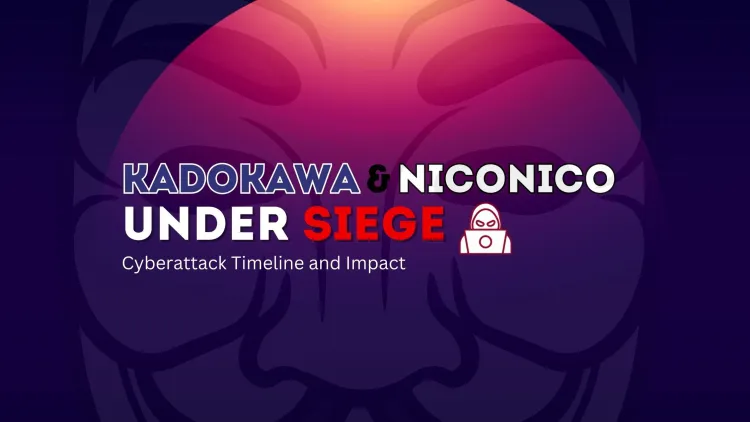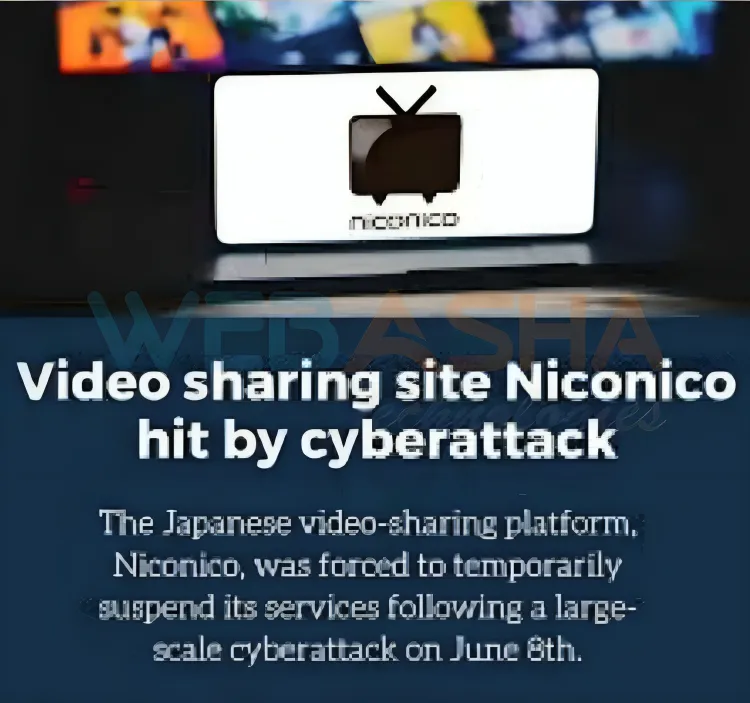Kadokawa and Niconico Under Siege | Cyberattack Timeline and Impact
The 2024 cyberattack on Kadokawa and Niconico, orchestrated by the hacker group BlackSuit, disrupted services and leaked the personal data of over 254,000 users. Beginning on June 8, 2024, this ransomware attack forced Kadokawa to shut down services, leading to significant operational and financial setbacks. The breach exposed vulnerabilities in Japan's cybersecurity landscape, primarily due to phishing tactics. In response, Kadokawa and Niconico implemented enhanced security measures and rebuilt systems to restore operations by August 5, 2024. This incident underscores the critical need for stronger cyber defenses and proactive strategies against ransomware attacks.

The 2024 cyberattack on Kadokawa Corporation and Niconico serves as a cautionary tale of how ransomware attacks can disrupt businesses and public platforms. Orchestrated by the Russian-linked hacker group BlackSuit, this attack underscores the growing cyber threats faced by organizations globally. Here's a detailed breakdown of the attack, its impact, and the aftermath.
Background
Niconico, launched in 2006, is a prominent Japanese video-sharing platform owned by Dwango, a subsidiary of Kadokawa Corporation. As of May 2022, it was ranked the 14th most visited website in Japan.
In early June 2024, Kadokawa Taiwan reported a cyberattack involving leaked personal and corporate data. Cybersecurity in Japan has often been criticized, with 90% of domestic companies lacking IT security specialists. This vulnerability was further highlighted a day before the attack when Japanese Prime Minister Fumio Kishida called for enhanced cybersecurity measures.

The Attack
-
Timeline of Events:
- June 8, 2024: Connection issues were reported across Kadokawa and Niconico services around 3:30 AM JST. Services were halted, and maintenance began.
- June 9, 2024: Kadokawa confirmed the ransomware attack and reported it to authorities. Despite initial countermeasures, attackers remotely restarted servers to propagate the malware, forcing Kadokawa to physically disconnect systems.
- June 14, 2024: Investigations revealed ransomware as the root cause. BlackSuit claimed responsibility and demanded ransom in exchange for 1.5 terabytes of stolen user and partner data.
-
BlackSuit's Role:
The group threatened to publish stolen data if the ransom was not paid by July 1, 2024. Kadokawa refused, and BlackSuit began releasing stolen data. -
Restoration Efforts:
Niconico launched a temporary website to keep users informed. Full services resumed on August 5, 2024.
Impact
-
Economic Repercussions:
- Kadokawa's stock price fell over 20% by July 3, 2024.
- Publishing operations and e-book distribution faced delays.
-
Operational Disruption:
- Niconico canceled all programming until the end of July.
- Kadokawa’s online shop and manufacturing processes were temporarily halted.
-
Data Breach:
- The attack led to the leak of 254,241 users’ data, including 186,269 records from Kadokawa Dwango Educational Institute.
Aftermath and Investigation
-
Security Overhaul:
Niconico implemented enhanced security measures and rebuilt its systems to prevent future attacks. -
Investigation Findings:
- The likely entry point was a phishing attack, a common and highly effective cyber threat vector.
- Kadokawa issued warnings against disseminating leaked data and took legal action where necessary.
Lessons Learned
-
Phishing Awareness:
Employees and organizations must recognize and counter phishing attempts through regular training and vigilant practices. -
Proactive Cybersecurity Measures:
Japan's cybersecurity landscape must evolve to address the shortage of IT experts and embrace stronger defensive mechanisms like active cyber defense strategies. -
Ransomware Preparedness:
Organizations must have robust disaster recovery plans and offline backups to mitigate ransomware's impact.
Conclusion
The Kadokawa and Niconico ransomware attack highlights the vulnerabilities in Japan's cybersecurity framework and serves as a wake-up call for organizations worldwide. With increasing reliance on digital platforms, bolstering cyber defenses, ensuring proactive threat mitigation, and cultivating cybersecurity awareness are essential to combating similar threats.
FAQs:
-
What was the 2024 cyberattack on Kadokawa and Niconico?
The attack was a ransomware incident orchestrated by the Russian-linked hacker group BlackSuit, targeting Kadokawa Corporation and its subsidiary Niconico, leading to data breaches and operational disruptions. -
When did the attack occur?
The attack began on June 8, 2024, and services were restored on August 5, 2024. -
Who was behind the attack?
The hacker group BlackSuit, known for ransomware attacks, claimed responsibility. -
How much data was compromised?
A total of 254,241 user records were leaked, including data from Kadokawa Dwango Educational Institute. -
What methods were used in the attack?
The attack exploited ransomware and was initiated through a phishing campaign. -
What were the immediate impacts of the attack?
Services were disrupted, Kadokawa’s stock price fell by over 20%, and publishing and e-book operations were delayed. -
What measures were taken to mitigate the attack?
Kadokawa disconnected affected servers, launched a temporary site, and implemented enhanced cybersecurity measures post-attack. -
Was any ransom paid?
No, Kadokawa refused to pay the ransom demanded by BlackSuit. -
What steps were taken to improve security after the attack?
Niconico rebuilt its systems and implemented new security protocols, while Kadokawa reinforced its cybersecurity policies. -
What lessons can organizations learn from this attack?
The incident highlights the importance of proactive cybersecurity measures, phishing awareness, and the need for a robust response plan to mitigate ransomware attacks.











![Top 10 Ethical Hackers in the World [2025]](https://www.webasha.com/blog/uploads/images/202408/image_100x75_66c2f983c207b.webp)



![[2025] Top 100+ VAPT Interview Questions and Answers](https://www.webasha.com/blog/uploads/images/image_100x75_6512b1e4b64f7.jpg)







